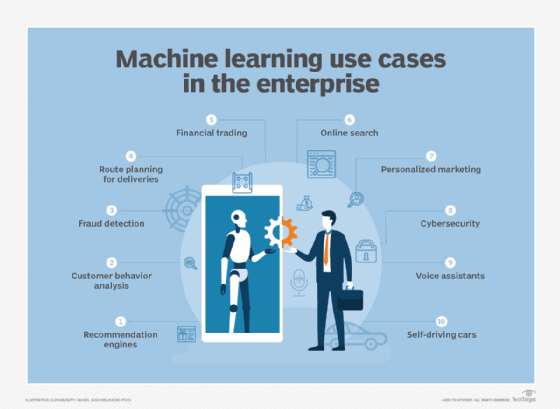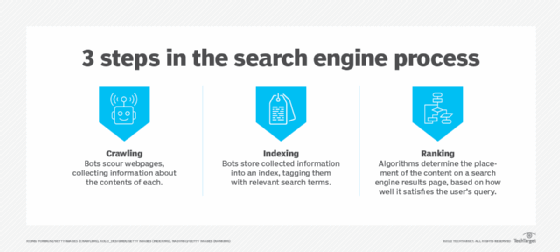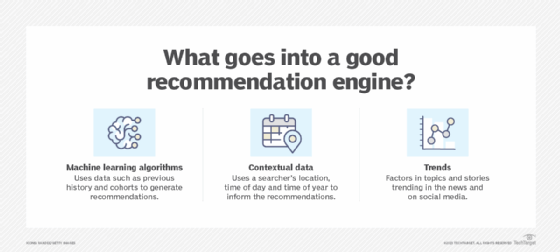
What is a recommendation engine?
A recommendation engine is a system that gives customers recommendations based on their behavior patterns and similarities to people who might have shared preferences. These systems, also known as recommenders, use statistical modeling, machine learning, and behavioral and predictive analytics algorithms to personalize the web experience.
E-commerce companies, social media platforms and content-based websites frequently use recommendation engines to generate product recommendations and relevant content that matches the characteristics of a particular web visitor. They are also used to suggest products that complement what a shopper has ordered. Search engines are a popular type of recommender, using a searcher's query and personal data, such as their location and browsing history, to generate relevant results.
A strong recommendation engine can improve a user's experience, increase conversions by turning browsers into buyers, boost revenue per order and build customer loyalty. According to Straits Research, the global recommendation engine market is expected to grow to $54 billion by 2030 from $3 billion in 2021, with a compound annual growth rate of 37%.
How do recommendation engines work?
Recommendation engines are software systems that apply algorithms and data analysis to make sense of data gathered about web visitors, customers and prospects. Recommenders use this understanding to suggest products these people are likely to buy or content they might be interested in.
This article is part of
What is enterprise AI? A complete guide for businesses
These engines typically have four recommendation stages:
- Data collection. Organizations collect relevant data about visitors. Data collection involves two types: implicit and explicit. Implicit data includes page views and time-on-page information. Explicit data is unstructured data, such as user comments, ratings, reviews, and likes and dislikes.
- Storage. Data is held in a database, data warehouse or customer data platform before analysis. The type of storage platform option used depends on the type of data used and the amount of data. Picking the right kind of storage enhances a recommendation engine's performance and scalability.
- Analysis. A recommendation algorithm analyzes customer data. There are various analytic techniques, such as similar user analysis, where a person is defined by their characteristics and made part of a cohort with shared preferences.
- Filtering. Irrelevant information is filtered out of the data to improve the accuracy and relevancy of the recommendations.

What are recommendation engines used for?
Companies and organizations use recommendation engines for different purposes. These use cases vary by industry.
E-commerce
These companies use recommendation engines to anticipate customer preferences and guide them to choices that better suit their needs. The goal is to encourage customers to buy more and engage in repeat business.
Companies such as Netflix and Amazon use recommendation engines to customize home screens with relevant product and content suggestions and popular items based on what they know about the person browsing. For example, after a customer buys a book on Amazon, the company recommends books on similar topics they might want to read, ones by the same author or ones that other customers have subsequently purchased. Netflix uses a viewer's history, cohorts and emotional analytics to recommend content they are likely to enjoy.
Search engines
Search engine providers use recommendation engines to return relevant content based on an individual user's search query. For example, Google uses a person's location, browsing history and other types of metadata to generate real-time results. Google and other search engines also use their recommendation engines to collect valuable data about a particular user, packaging their searches and selling this information to advertisers in surveillance capitalism.

Social media
Platforms such as Facebook; Instagram; TikTok; and X, formerly Twitter, use recommendation engines to suggest new content and people to follow.
Artificial intelligence for IT operations
AIOps uses recommendation engines to analyze data from distributed networks and recommend solutions. AIOps automates problem detection in IT infrastructure.
What are the different types of recommendation engines?
Different types of recommendation engines use various metrics. The most common recommendation engine types are the following:
- Collaborative filtering. Streaming services commonly use this filtering method. Collaborative filtering collects user activity and behavior data and uses it to define preferences and predict future behavior. Recommendations are made based on the user's similarity to other people and the assumption that they might like related items or actions. E-commerce sites use this type of recommender to suggest products within certain categories. Collaborate filtering requires a lot of maintenance to update and keep accurate, making it difficult for high-volume businesses.
- Content-based filtering. This analytical approach compares a person's preferences to descriptions of products or items. The descriptions include keywords that are used to track and define user behavior. This method assumes that if a person likes a product, they are likely to want a similar item that the content-based recommender suggests.
- Hybrid recommendation systems. These systems combine elements of collaborative and content-based filtering. The hybrid approach is considered the most accurate recommendation engine.

How to build a recommendation engine
A recommendation engine is tailored to meet an organization's needs. However, the basic process of building one before customizing it typically includes the following six steps:
- Purpose and scope. Prior to starting any development activities, it's important to determine the recommendation engine's purpose and narrow its scope to target specific customers. This reduces the budget and resources that might be wasted with an unnecessarily broad scope.
- Data collection and cleansing. Information is gathered about customers' purchase histories, product reviews and interactions with sales and customer service teams. That data is formatted, and values are labeled so the model understands what to do with it.
- Model training. Developers have different methods available to them, such as collaborative or content-based filtering, to train a model to discover insights from training data. Other techniques include matrix factorization, a collaborative filtering technique that narrows a list of items to the most suitable ones for a customer based on similarities between the items and the customer. Various programming languages, such as Python, and libraries, such as TensorFlow, are used to simplify this process.
- Testing. Prototype testing reveals how the recommendation engine works in real-world scenarios. Functionality problems are identified before the official model is deployed.
- Deployment. Once the prototype is successfully tested, the finished model is integrated with a business's existing tech infrastructure, including servers and applications.
- Monitoring. The model's performance is tracked on an ongoing basis to spot defects and retrain it with new data if needed.
Recommendation engine benefits
Recommendation engines require a budget as well as time and effort to create. However, they are increasingly vital given their business value. The benefits of recommendation engines include the following:
- Product exposure. Recommendation engines expand the number of items a website visitor looks at and potentially buys. This can increase an e-commerce site's traffic volume and revenue.
- Customer experience. Making it easy for customers to find, browse and buy relevant products streamlines the customer experience and simplifies their work.
- Customer satisfaction. Good customer experiences are typically gauged with online reviews or surveys. Positive feedback lets potential customers know that others were satisfied with their experience and past purchases.
- Customer retention and loyalty. Good customer experience can also lead to long-term customer retention and brand loyalty.
- Cross-selling. Recommendation engines ensure customers view the benefits of products compatible with or typically purchased alongside previously purchased products. This can increase sales.
- Customer conversion rates. Recommendation engines help businesses fine-tune their sales strategies in ways that improve customer conversion rates.
Recommendation engine drawbacks
Despite multiple benefits, recommendation engines have numerous challenges and limitations. They include the following:
- Data quality. Recommendation engines depend on quality data to work well. Incomplete or linguistically ambiguous data can affect the relevancy or value of recommendations.
- Data types. Recommendation engines typically struggle with certain types of unstructured data, such as images, because their training data must be formatted and labeled correctly to understand customer preferences. Unlabeled images make identifying what the model should look for difficult.
- Lack of dates and times. These engines sometimes have difficulty incorporating time into their models. For example, a recommendation engine that doesn't have a sense of the seasons where a customer lives might not suggest the right type of clothing to specific shoppers.
- Cold starts. Recommendation engines are trained on historical customer data, but they might have limited historical data when dealing with new customers. This is known as the cold start problem.
- Tracking customer reactions. Customer reactions to suboptimal recommendations can be difficult to identify and track.
- Bias. Biases in artificial intelligence (AI) and machine learning algorithms can lead to inaccurate recommendations.
- Compliance. Compliance rules can make it difficult for organizations to gather and store data. For example, the European Union's AI Act requires businesses to prove their data collection and storage methods don't infringe on the privacy of EU citizens.
- Customer skepticism. Some users might choose not to opt into an organization's data collection efforts out of privacy concerns.

The future of recommendation engines
Recommendation engines depend on relatively new technology that's still evolving, such as machine learning, deep learning, AI and big data. Deep learning and neural networks aim to improve recommendation engines' ability to incorporate seasonal preferences and record users' reactions to suboptimal recommendations. This will enable these engines to generate more detailed and accurate user profiles.
Applications and techniques such as AI-driven natural language processing (NLP) are also affecting the future of recommenders. Improvements in NLP's ability to understand unstructured text and data are making the recommendations these engines provide more accurate.
Search engines like Bing and Google are starting to incorporate generative AI capabilities. These programs can generate original, real-time answers to search queries instead of returning pages of results from different authors. This user-based technology is a significant development for recommenders but comes with its own rewards and challenges.
Recommendation engines are an important application of machine learning systems. Learn more about the use of machine learning in the enterprise.